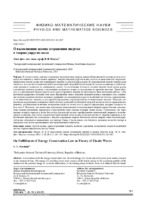| dc.contributor.author | Невдах, В. В. | |
| dc.coverage.spatial | Минск | ru |
| dc.date.accessioned | 2021-04-08T07:40:45Z | |
| dc.date.available | 2021-04-08T07:40:45Z | |
| dc.date.issued | 2021 | |
| dc.identifier.citation | Невдах, В. В. О выполнении закона сохранения энергии в теории упругих волн = On Fulfillment of Energy Conservation Law in Theory of Elastic Waves / В. В. Невдах // Наука и техника. – 2021. – № 2. – С. 161-167. | ru |
| dc.identifier.uri | https://rep.bntu.by/handle/data/90019 | |
| dc.description.abstract | В соответствии с законом сохранения энергии полная энергия замкнутой физической системы должна оставаться постоянной в любой момент времени. Энергия бегущей упругой волны состоит из кинетической энергии колеблющихся частиц среды и потенциальной энергии ее упругой деформации. В существующей теории упругих волн считается, что плотности кинетической и потенциальной энергий бегущей волны без потерь одинаковы в любой момент времени и меняются по одинаковому закону. Соответственно плотность полной энергии такой волны разная в различные моменты времени, а постоянным сохраняется только ее усредненное по времени значение. Таким образом, в существующей теории упругих волн закон сохранения энергии не выполняется. Цель настоящей работы – дать физически корректное описание этих волн. Предложено новое описание звуковой волны в идеальном газе, основанное на использовании системы волновых уравнений для возмущения скорости колебаний частиц газа, определяющего их кинетическую энергию, и для упругой деформации, определяющей их потенциальную энергию. Показано, что физически корректными решениями такой системы уравнений для бегущей звуковой волны являются гармонические решения, описывающие колебания возмущения скорости частиц газа и упругой деформации, которые сдвинуты по фазе на /2. Получено, что положения максимумов кинетической и потенциальной энергий упругой волны, описываемых такими решениями, чередуются в пространстве через каждые четверть длины волны. Установлено, что через каждые четверть периода в волне без потерь происходит полное преобразование кинетической энергии в потенциальную и обратно, при этом в каждой пространственной точке волны ее полная плотность энергии одинакова в любой момент времени, что согласуется с законом сохранения энергии. Плотность потока энергии такой бегущей упругой волны описывается выражением для вектора Умова. Сделан вывод, что бегущую звуковую волну без потерь в идеальном газе можно рассматривать как гармонический осциллятор. | ru |
| dc.language.iso | ru | ru |
| dc.publisher | БНТУ | ru |
| dc.title | О выполнении закона сохранения энергии в теории упругих волн | ru |
| dc.title.alternative | On Fulfillment of Energy Conservation Law in Theory of Elastic Waves | ru |
| dc.type | Article | ru |
| dc.identifier.doi | 10.21122/2227-1031-2021-20-2-161-167 | |
| local.description.annotation | In accordance with the energy conservation law, the total energy of a closed physical system must remain constant at any moment of time. The energy of a traveling elastic wave consists of the kinetic energy in the oscillating particles of the medium and the potential energy of its elastic deformation. In the existing theory of elastic waves, it is believed that the kinetic and potential energy densities of a traveling wave without losses are the same at any moment of time and vary according to the same law. Accordingly, the total energy density of such wave is different at various moment of time, and only its timeaveraged value remains constant. Thus, in the existing theory of elastic waves, the energy conservation law is not fulfilled. The purpose of this work is to give a physically correct description of these waves. A new description of a sound wave in an ideal gas has been proposed and it is based on the use of a wave equation system for perturbing the oscillation velocity of gas particles, which determines their kinetic energy, and for elastic deformation, which determines their potential energy. It has been shown that harmonic solutions describing the oscillations of the gas particles velocity perturbation and their elastic deformation, which are phase shifted by /2, are considered as physically correct solutions of such equations system for a traveling sound wave. It has been found that the positions of the kinetic and potential energy maxima in the elastic wave, described by such solutions, alternate in space every quarter of the wavelength. It has been established that every quarter of a period in a wave without losses, the kinetic energy is completely converted to potential and vice versa, while at each spatial point of the wave its total energy density is the same at any time, which is consistent with the energy conservation law. The energy flux density of such traveling elastic wave is described by the expression for the Umov vector. It has been concluded that such traveling sound wave without losses in an ideal gas can be considered as a harmonic oscillator. | ru |

